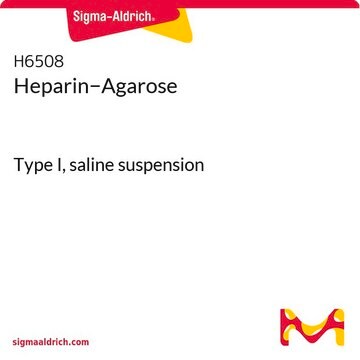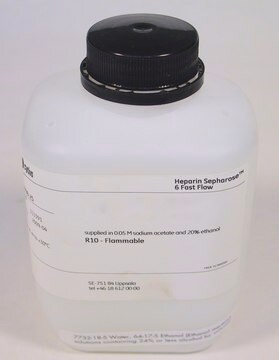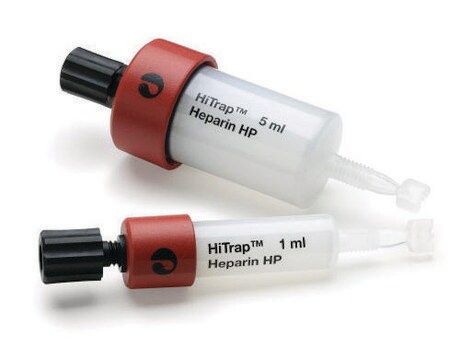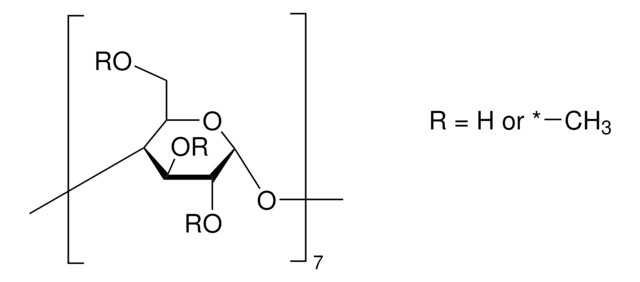H0402
Heparin−Agarose
(1:1 suspension in a 20% ethanol solution)
Iniciar sesiónpara Ver la Fijación de precios por contrato y de la organización
About This Item
Productos recomendados
origen biológico
heparin from Porcine intestinal mucosa
Nivel de calidad
Formulario
(1:1 suspension in a 20% ethanol solution)
Matriz
4% beaded agarose
activación de la matriz
epichlorohydrin
unión a la matriz
terminal aldehyde by reductive amination to amine linker
espaciador de matriz
7 atoms
capacidad
≥0.5 mg/mL binding capacity (thrombin)
temp. de almacenamiento
2-8°C
¿Está buscando productos similares? Visita Guía de comparación de productos
Aplicación
Heparin agarose is developed from porcine intestinal mucosa and is used in affinity chromatography. Heparin agarose has been used in studies to provide information on human monocytic ehrlichiosis, tumor necrosis and the effects of coagulation from Vipera snake venom.
Forma física
1:1 suspension in a 20% ethanol solution
Nota de preparación
Prepared by end-point attachment for high-efficiency fractionation of antithrombin III and other specific binding proteins
Palabra de señalización
Warning
Frases de peligro
Consejos de prudencia
Clasificaciones de peligro
Flam. Liq. 3
Código de clase de almacenamiento
3 - Flammable liquids
Clase de riesgo para el agua (WGK)
WGK 3
Punto de inflamabilidad (°F)
104.0 °F - closed cup
Punto de inflamabilidad (°C)
40 °C - closed cup
Elija entre una de las versiones más recientes:
¿Ya tiene este producto?
Encuentre la documentación para los productos que ha comprado recientemente en la Biblioteca de documentos.
Los clientes también vieron
Kenji Kashiwagi et al.
Biomaterials, 30(6), 1166-1175 (2008-11-22)
Efficient immobilization of biomacromolecules on material surfaces is a key to development in areas of regenerative medicine and tissue engineering. However, strong and irreversible immobilization of cytokines on surfaces often diminishes their biological functionality. A destructive hydrophobic interaction between the
W H Yu et al.
The Journal of biological chemistry, 275(6), 4183-4191 (2000-02-08)
Many matrix metalloproteinases (MMPs) are tightly bound to tissues; matrilysin (MMP-7), although the smallest of the MMPs, is one of the most tightly bound. The most likely docking molecules for MMP-7 are heparan sulfate proteoglycans on or around epithelial cells
Glycosaminoglycan binding assays.
A J Hoogewerf et al.
Methods in molecular biology (Clifton, N.J.), 138, 173-177 (2000-06-07)
B A Kluszynski et al.
The Journal of biological chemistry, 272(21), 13541-13547 (1997-05-23)
We have studied the ability of histidine-rich glycoprotein (HRG) to neutralize the anticoagulant activity of heparin in plasma and in a purified component clotting assay. Addition of HRG to plasma or to the purified component assay did not neutralize the
Miriam Corredor et al.
Biophysical journal, 110(6), 1291-1303 (2016-03-31)
Semaphorin3A (Sema3A) is a vertebrate-secreted protein that was initially characterized as a repulsive-guidance cue. Semaphorins have crucial roles in several diseases; therefore, the development of Sema3A inhibitors is of therapeutic interest. Sema3A interacts with glycosaminoglycans (GAGs), presumably through its C-terminal
Nuestro equipo de científicos tiene experiencia en todas las áreas de investigación: Ciencias de la vida, Ciencia de los materiales, Síntesis química, Cromatografía, Analítica y muchas otras.
Póngase en contacto con el Servicio técnico










